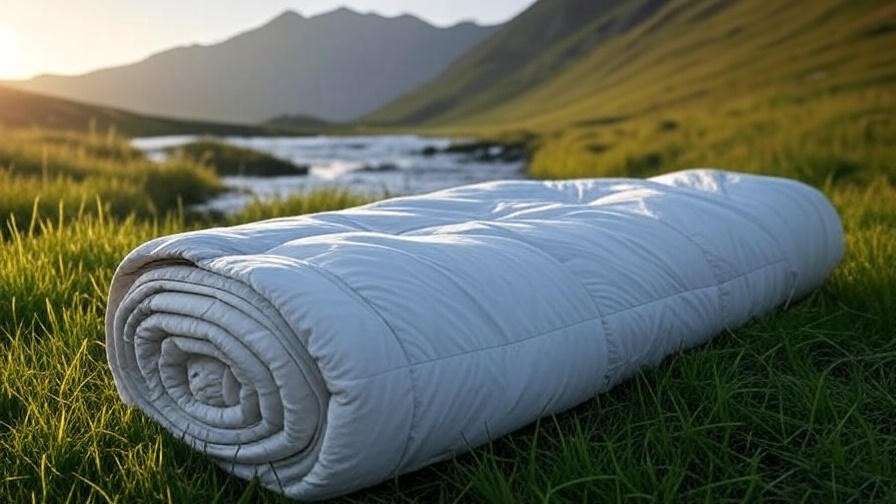Imagine sinking into your sleeping bag after a long day of hiking, only to be met with musty odors or itchy allergens that disrupt your rest. A clean sleeping bag isn’t just about hygiene—it’s a cornerstone of restorative sleep and holistic well-being during outdoor adventures. Learning how to clean a sleeping bag properly ensures you enjoy cozy, allergen-free nights under the stars while extending the life of your gear. As an avid camper with over a decade of experience in outdoor gear maintenance and a passion for sleep wellness, I’ve mastered the art of keeping sleeping bags fresh and functional. In this comprehensive guide, you’ll discover expert-backed techniques to clean, maintain, and store your sleeping bag, ensuring better sleep and lasting durability.
Why Cleaning Your Sleeping Bag Is Essential
A clean sleeping bag is more than a luxury—it’s a necessity for health, comfort, and gear longevity. Let’s explore why regular cleaning should be part of your outdoor routine.
Impact on Sleep Quality
Dirt, sweat, and body oils accumulate in your sleeping bag, creating an environment that can disrupt your sleep. A grimy bag may feel less cozy, smell unpleasant, or even cause skin irritation, all of which hinder the deep, restorative rest you need after a day outdoors. For those who value mindfulness and holistic well-being, a clean sleeping bag creates a serene sleep sanctuary, enhancing relaxation and recovery. Studies, like those from the National Sleep Foundation, show that a hygienic sleep environment promotes better sleep quality, which is vital for mental clarity and physical health.
Health and Hygiene Benefits
Unclean sleeping bags can harbor allergens, dust mites, and bacteria, posing risks especially for those with allergies or respiratory conditions like asthma. These microscopic invaders thrive in damp, sweaty fabrics, potentially triggering sneezing, itching, or breathing difficulties. Regular cleaning eliminates these health hazards, ensuring your sleeping bag remains a safe haven for rest. For sensitive individuals, a clean bag can mean the difference between waking up refreshed or battling discomfort all night.
Prolonging Sleeping Bag Lifespan
High-quality sleeping bags are an investment, often costing hundreds of dollars. Neglecting proper care can degrade insulation, damage zippers, or wear out waterproof coatings, reducing both comfort and functionality. Regular cleaning prevents material breakdown, preserving the bag’s warmth and loft. By maintaining your gear, you save money in the long run and ensure it’s ready for countless adventures.
Understanding Your Sleeping Bag’s Material and Care Requirements
Before diving into cleaning, it’s crucial to understand your sleeping bag’s materials and specific care needs to avoid costly damage.
Types of Sleeping Bags
Sleeping bags typically feature either down or synthetic insulation, each with unique care requirements. Down bags, filled with duck or goose feathers, offer superior warmth-to-weight ratios but are delicate and prone to clumping if mishandled. Synthetic bags, made with polyester fills, are more durable but can lose insulation properties if exposed to high heat. Shell fabrics, like nylon or polyester, often have waterproof or water-resistant coatings that require gentle cleaning to stay effective. Always check the manufacturer’s care label for specific instructions, as some brands recommend particular detergents or washing methods.
Common Cleaning Challenges
Cleaning a sleeping bag isn’t as simple as tossing it in a regular wash. Down bags risk losing their loft if not dried properly, while synthetic bags can suffer from melted fibers under high heat. Zippers and seams are vulnerable to snagging or tearing, and harsh detergents can strip protective coatings. Understanding these challenges helps you choose the right cleaning approach to maintain your bag’s performance.
Expert Insight: “Proper care is key to preserving a sleeping bag’s insulation and durability,” says Sarah Thompson, a gear specialist with 15 years at REI. “Always follow the care label and use specialized detergents to protect your investment.”
Step-by-Step Guide to Cleaning a Sleeping Bag
Whether you’re hand-washing or using a machine, these expert steps will keep your sleeping bag fresh and functional.
Preparing to Clean
Before washing, gather your supplies: a mild, non-detergent soap like Nikwax Down Wash Direct or Granger’s Performance Wash, a large tub or front-loading washer, and tennis balls for drying down bags. Inspect your bag for stains, tears, or loose seams, and address minor damage with repair tape or patches. Spot-treat stains with a soft brush and a dab of detergent to avoid spreading dirt during the wash.
Hand-Washing a Sleeping Bag

Hand-washing is the safest method for delicate bags, especially down-filled ones. Follow these steps:
- Fill a Tub: Use a large bathtub or basin with lukewarm water (avoid hot water to protect insulation).
- Add Detergent: Mix in a small amount of specialized detergent, following the product’s instructions.
- Soak and Agitate: Submerge the bag and gently knead it to loosen dirt. Let it soak for 15–30 minutes.
- Rinse Thoroughly: Drain the soapy water and refill with clean water to rinse. Repeat until no suds remain.
- Gently Squeeze: Press out excess water without wringing to avoid damaging fibers.
Tip: For stubborn odors, add a half-cup of baking soda to the soak for natural deodorizing.
Machine-Washing a Sleeping Bag
If hand-washing isn’t feasible, use a front-loading washer to minimize damage. Avoid top-loading machines with agitators, which can tear seams or clump insulation. Here’s how:
- Set the Machine: Use a gentle cycle with cold or lukewarm water and an extra rinse cycle.
- Add Detergent: Use a small amount of mild, specialized detergent.
- Wash Carefully: Zip up the bag and turn it inside out to protect the shell. Wash alone to avoid snagging.
- Double Rinse: Ensure all detergent is removed to prevent residue buildup.
Drying Your Sleeping Bag
Proper drying is critical to prevent mold and maintain loft. Air-drying is ideal but time-consuming; a low-heat dryer works well if done carefully.
- Air-Drying: Lay the bag flat on a clean surface or hang it in a well-ventilated area away from direct sunlight. Flip it periodically to ensure even drying.
- Dryer Method: Use a large, front-loading dryer on low or no heat. Add 2–3 clean tennis balls for down bags to break up clumps and restore loft. Check every 20 minutes to avoid overheating.
- Ensure Complete Dryness: Drying may take several hours. A damp bag can develop mold, so be patient.
Tip Box:
- Do: Use mild detergents, zip up the bag before washing, and dry thoroughly.
- Don’t: Use bleach, fabric softeners, or high heat, as these can damage insulation and coatings.
Special Considerations for Down vs. Synthetic Sleeping Bags
Each type of sleeping bag requires tailored care to maintain its unique properties.
Cleaning Down Sleeping Bags
Down bags are prized for their warmth but require extra caution to prevent clumping. Use a down-specific detergent like Nikwax Down Wash Direct to preserve the natural oils in the feathers. Avoid over-soaking, and ensure thorough rinsing to prevent residue. During drying, check frequently to fluff the bag and break up clumps. A well-maintained down bag can last decades with proper care.
Cleaning Synthetic Sleeping Bags
Synthetic bags are more forgiving but still sensitive to heat. Use a synthetic-specific detergent like Granger’s Performance Wash to clean without compromising insulation. Avoid high-heat drying, as it can melt polyester fibers, reducing warmth. Synthetic bags dry faster than down, but always confirm they’re fully dry before storing.
Expert Insight: “Down and synthetic bags both need gentle care, but down is especially delicate,” notes gear manufacturer Patagonia’s product care team. “Use specialized products and low heat to keep your bag performing at its best.”
Maintaining Your Sleeping Bag Between Washes
Regular maintenance reduces the need for frequent deep cleaning, saving time and preserving your bag.
Using a Sleeping Bag Liner
A lightweight cotton or silk liner acts as a barrier, keeping body oils and sweat off your bag. Liners are easy to wash and dry, extending the time between full cleanings. For hot sleepers, a breathable liner also enhances comfort, aligning with holistic sleep practices by maintaining a fresh sleep environment.
Proper Storage Techniques
Improper storage can compress insulation or invite mold. Store your sleeping bag loosely in a large, breathable cotton or mesh sack, not its compression sack. Keep it in a cool, dry place away from dampness or direct sunlight. For long-term storage, hang the bag to maintain loft and prevent flat spots.
On-the-Go Cleaning Tips
While camping, air out your bag daily to prevent moisture buildup. For minor stains, spot-clean with a damp cloth and a drop of mild soap. Use a portable odor-eliminating spray, like Gear Aid ReviveX, for quick freshness on the trail. These habits keep your bag clean and ready for restful sleep.
Common Mistakes to Avoid When Cleaning a Sleeping Bag
Avoid these pitfalls to protect your gear and ensure effective cleaning:
- Using Harsh Detergents or Bleach: These strip protective coatings and damage insulation. Stick to mild, specialized cleaners.
- Improper Drying: High heat or incomplete drying can cause mold or clumping. Always use low heat and confirm dryness.
- Ignoring Care Labels: Manufacturer instructions are tailored to your bag’s materials. Disregarding them risks damage or voided warranties.
Eco-Friendly and Holistic Cleaning Practices
For those who prioritize sustainability and holistic well-being, cleaning your sleeping bag with environmentally conscious methods aligns with mindful outdoor practices. These approaches reduce your ecological footprint while keeping your gear fresh and functional.
Choosing Eco-Friendly Detergents

Opt for biodegradable, non-toxic detergents like Nikwax Tech Wash or Granger’s Eco Wash, which are free of harsh chemicals like phosphates. These products clean effectively without harming the environment or leaving residues that could irritate your skin. By choosing eco-friendly options, you support a healthier planet and create a cleaner sleep environment, resonating with the principles of holistic wellness.
Reducing Water and Energy Use
Minimize your environmental impact by using efficient cleaning methods. Hand-washing in a tub conserves water compared to multiple machine cycles. If machine-washing, use a front-loading washer, which uses less water and energy than top-loaders. For drying, air-drying is the most energy-efficient option, though it requires patience. If using a dryer, stick to low-heat settings and avoid over-drying to save energy. These practices align with mindful living, ensuring your outdoor adventures don’t come at the expense of the environment.
Expert Insight: “Sustainable gear care reflects a deeper respect for nature,” says Dr. Emily Chen, an environmental sleep researcher. “Eco-friendly cleaning not only preserves your sleeping bag but also supports the ecosystems you explore.”
Troubleshooting Common Sleeping Bag Cleaning Issues
Even with careful cleaning, issues like odors or loss of loft can arise. Here’s how to address them effectively.
Dealing with Persistent Odors
If your sleeping bag retains musty smells after washing, try a natural deodorizing soak. Add a half-cup of baking soda or white vinegar to the rinse water and let the bag soak for an hour before rinsing thoroughly. For on-the-go solutions, use an odor-eliminating spray designed for outdoor gear, such as Gear Aid ReviveX Odor Eliminator. Avoid masking odors with fragrances, as they can attract insects or irritate sensitive skin.
Restoring Loft in Down Bags

Down bags may lose their fluffiness if not dried properly. To restore loft, place the bag in a low-heat dryer with 2–3 clean tennis balls for 20–30 minutes after it’s fully dry. Alternatively, shake and fluff the bag by hand, gently pulling apart clumps. Regular maintenance, like airing out the bag after use, helps maintain loft between washes.
Repairing Minor Damage
Small tears or stuck zippers can compromise your bag’s performance. Patch minor rips with gear repair tape, like Tenacious Tape, or sew them with a needle and thread for a permanent fix. For sticky zippers, clean them with a toothbrush and mild soap, then apply a silicone-based lubricant like Gear Aid Zipper Cleaner. These fixes keep your bag functional and comfortable.
FAQ Section:
- How often should I clean my sleeping bag? Wash it every 10–20 uses or once per season for frequent campers, depending on dirt and odor buildup.
- Can I dry-clean a sleeping bag? Most manufacturers advise against dry-cleaning, as chemicals can damage insulation and coatings. Always check the care label.
- What if my bag still smells after washing? Try a baking soda soak or consult the manufacturer for specialized cleaning advice.
- How do I clean a waterproof sleeping bag? Use a tech-specific detergent like Nikwax Tech Wash to preserve water-repellent coatings.
- Can I wash my sleeping bag with regular detergent? Avoid regular detergents, as they can strip protective coatings and leave residues.
How a Clean Sleeping Bag Enhances Holistic Well-Being
A clean sleeping bag does more than keep you warm—it supports your mental and physical health, aligning with the principles of holistic well-being.
Connection to Better Sleep
A hygienic sleeping bag creates a comfortable, inviting sleep environment, crucial for deep, restorative rest. Whether you’re camping in the wilderness or practicing mindfulness in nature, a clean bag enhances relaxation by eliminating distractions like odors or allergens. According to a 2023 study in the Journal of Sleep Research, a clean sleep setup improves sleep onset and duration, helping you wake up refreshed for the day’s adventures.
Mental Health Benefits

A fresh, comfortable sleeping bag reduces stress and promotes a sense of calm, especially during outdoor experiences. The act of caring for your gear can also be a mindful practice, fostering a deeper connection to your environment. For those who use camping as a form of meditation or retreat, a clean sleeping bag reinforces the tranquility of the experience, supporting mental clarity and emotional balance.
Expert Insight: “A clean sleep environment is a foundation for mental wellness,” says Dr. Lisa Harper, a sleep therapist specializing in outdoor therapy. “When your gear feels fresh, it signals to your brain that it’s time to unwind and recharge.”
Conclusion
Cleaning your sleeping bag is a vital step toward better sleep, improved health, and prolonged gear life. By following the expert steps outlined—choosing the right detergent, washing gently, drying thoroughly, and maintaining your bag between uses—you’ll ensure cozy, hygienic nights outdoors. Embrace eco-friendly practices to align with holistic well-being and sustainability, and avoid common mistakes to protect your investment. Whether you’re a weekend camper or a seasoned backpacker, a clean sleeping bag enhances your connection to nature and supports restorative rest. Try these techniques on your next wash, and share your tips in the comments below to join our community of mindful adventurers!













